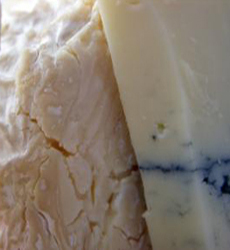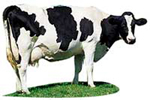
 Blue cheeses are injected with Penicillium roqueforti, Penicillium gorgonzola or Penicillium glaucum spores to develop their famous blue veins. Yes, they’re relatives of the life-saving antibiotic. These beautiful gourmet blue cheeses were photographed by Csaba Moldován | SXC. Blue cheeses are injected with Penicillium roqueforti, Penicillium gorgonzola or Penicillium glaucum spores to develop their famous blue veins. Yes, they’re relatives of the life-saving antibiotic. These beautiful gourmet blue cheeses were photographed by Csaba Moldován | SXC.
|
 |

Gourmet Cheese
Gourmet Cheeses—Farmstead & Artisan*—For Yourself & For Gifts
While cheese dates back to before recorded history, the art of cheesemaking as we know it today was refined in the Roman Empire. Ancient Roman cheesemakers developed many varieties of cheese that resemble those we currently enjoy, and became skilled artisans. They understood how various ripening techniques impacted the taste and character of the cheese, and are credited with being the first to age cheese (or more precisely, to store it). Most probably, the Roman legions brought cheese and cheesemaking to what are now France and England—where later, in France the art of aging cheese, or l’affinage, was perfected. Today’s artisan cheesemakers continue this ancient craft—and some continue the innovation as well.
- As with any top-of-the-line product, be it a suit, a violin or a Camembert, the components for success are ingredients and craftsmanship (and some would add, passion for one’s work). The best cheese is made from the best milk, which requires top animal stock and top grazing land; plus impeccable barns and cheese-making facilities.
- While today’s artisan cheesemakers may use state-of-the-art equipment to pasteurize, brine and cure their cheeses, they generally pursue farming and animal husbandry “the old-fashioned way”—without spraying their pastures with herbicides and pesticides, without injecting their animals with hormones or unnecessary antibiotics. This gives the lover of fine cheese, the best of both worlds.
In this section we sharing some of our favorite gourmet cheeses that we enjoy ourselves and recommend as gourmet cheese gifts. There are articles about serving cheese, cheese-making and reference guides that we hope you’ll find interesting. Don’t overlook How To Taste Cheese and Have a Cheese Tasting Party, as well as our Glossary of Cheese Terms. Feel free to suggest additional topics for articles about cheese.
| |
* |
Farmstead and artisanal cheeses are handcrafted in small batches. A farmstead cheese is one that is made on the farm from the milk of the farm’s animals. An artisan cheese is by cheese makers who live near farms and purchase their milk from farmers. While starting with top quality milk is key, cheesemaking is a craft: Owning one’s animals does not make one a better cheesemaker than purchasing one’s milk. |
| Articles About Types Of Cheese |
Reviews Of Gourmet Cheese Brands
& Cheese Makers |
|
|
| Reference Articles About Cheese |
Recipes |
|
Appetizers, First Courses & Snacks
Main Dishes, Sandwiches & Sides
Desserts
|
| Serving Suggestions |
|
Nibble Tip
Did you ever wonder why only the U.S. and Europe are known as major producers of artisan cheese?
After weaning, most of the world’s populations are lactose-intolerant. People of European ancestry have the genetic ability to consume milk-based products to their hearts’ delight. Lactose-intolerant people can’t digest cow’s milk proteins easily, but goat’s milk is more easily digestible. Many lactose-intolerant people also enjoy sheep and buffalo milk cheeses. And the more a cheese ages—even a cow’s milk cheese—the less lactose it contains. There’s very little in a three-year-old Parmigiana-Reggiano, for example. |
|

Alas, most of the world’s human
populations have difficulty digesting cow’s milk products. Photo courtesy of Cabot Creamy Cooperative.
|

|
|





